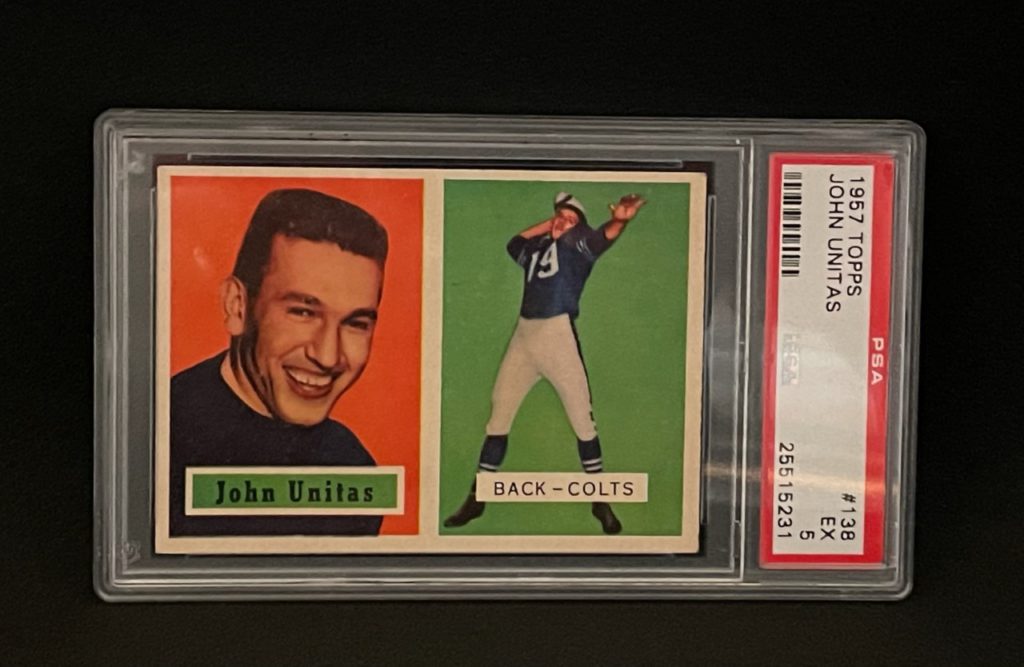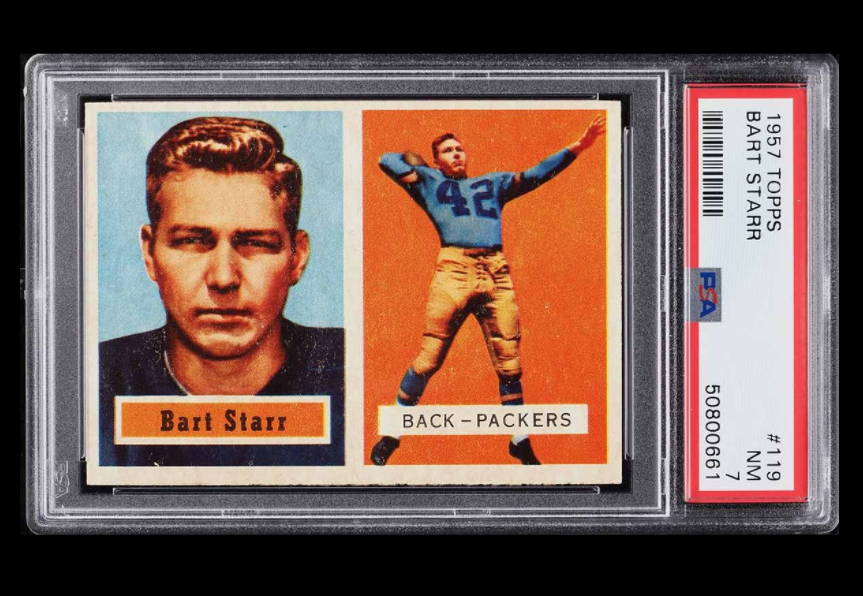Every decade has its share of great quarterbacks. The 1950s ushered in two generational greats as Bart Starr and Johnny Unitas took over. They both played from the second half of the 1950s all the way through the 1960s and into the early 1970s. Both quarterbacks would have been wanted by any team of the era, both had tremendous winning records and great statistics. Both Unitas and Starr have prized rookies from the 1957 Topps football set.
This is the 1957 Topps Football Rookie Challenge. Do collectors (and investors) prefer the Bart Starr rookie card or the Johnny Unitas rookie card?
Picking a favorite player, even among the greats, can be like arguing about pizza toppings. Bart Starr’s rookie is more rare among graded populations than the Unitas rookie card. Bart Starr’s stats were impressive in that generation but Unitas ended up with better career statistics.
The Johnny Unitas rookie card is actually the most sought after card in this 1957 tops set. Grail collectors and those who invest in vintage sports cards need to understand that high-grades of both come at serious premiums, and neither card has a perfect PSA 10 grade.
TOPPS HAD DIFFICULTIES IN 1957
Topps had challenging issues in 1957 that impacted their sports card sets – baseball, basketball and football. It had absorbed Bowman barely a year earlier. The company chopped its larger card size down to smaller format cards which are basically still the card-size standard today. Topps was also experimenting with new printing techniques and paper. Many 1957 Topps baseball cards with the full photo can have condition degradation on the images, and the 1957 to 1958 Topps basketball set is notorious for its poor condition grades.
The double-printed images for the 1957 football set were separated with a portrait and an action shot. Each contained different background colors. This allowed for many printing defects to visually stand out in the cards. The 1957 Topps football set is known for poor centering issues and printing smudges. Strong eye appeal is always more visible in high-grade versus mid-grade and low-grade cards, but this is even more evident in the 1957 Topps cards.
All of the issues above led to low populations of high-grade examples in the set at the PSA 8 and higher. PSA’s total graded 1957 Topps football population is 60,650 graded examples. Of this large sum, only 20 examples of any card (and none of the super-star cards) in the set have the perfect Gem Mint PSA 10 grade.
Topps released the 1957 football set in two series. its first group of 88 cards has a larger population, and the high-number run of 66 cards is where the top 3 rookies of the set come in. Topps also only listed the quarterbacks on these cards as “Back” rather than “Quarterback” for their position.

PLAYER VERSUS PLAYER CAREER STATS
Bart Starr was one of the top quarterbacks of his generation. From 1956 to 1971 he led the Packers to six division titles, five NFL titles and two Super Bowl titles. Bart Starr played in 196 games and ended with 24,718 yards passing. He had 152 touchdowns credited and a 57.4% percentage completion rate.
What really made Bart Starr shine was that he would clinch a game in a clutch situation. Under the leadership of the great Vince Lombardi, Bart Starr was part of one of the fantasy teams that made up historic football.
This may sound similar to the current GOAT named Brady of the modern era, but Johnny Unitas was drafted very late (in the ninth round). Unitas was swiftly cut by the Steelers after their coach was against Unitas and in favor of another. The Colts picked Johnny Unitas up after he was playing in a semi-pro league, and history will judge that Unitas ironically barely made it into the NFL before becoming known as a quarterback that would drive the Colts to victory.
Johnny Unitas had over 40,000 passing yards after a 211 game career. From 1956 to 1960, Unitas set a record with 47 consecutive games with a touchdown pass. That record held for 52 years. Unitas ended with 290 touchdown passes. His statistics are actually better than Bart Starr ‘s over the course of his career. Unitas had 40,239 passing yards from 1956 to 1973 and a 54.6% completion rate. Unitas managed to win four championship titles; three pre-merger era and one Super Bowl.
ROOKIE CARD POPULATIONS
Johnny Unitas has many more rookie cards than Bart Starr. PSA’s total count is 3,659 graded examples for Unitas and 2,000 total graded examples for Starr. Again, high-grade examples are rare and no “Perfect Gem Mint PSA 10” grades exist for either. The concentration with the highest count of grades is similar for each card by PSA and SGC standards.
Of the total 3,659 PSA graded examples of the Unitas rookie, the highest grade concentration is 867 at PSA 6. There are just 190 PSA 8 examples and only 8 PSA 9 grades. SGC’s total count is 743 Unitas graded cards. SGC also has a highest concentration at 5 with 100 graded examples, and it only counts 3 cards at SGC 9.
The total population of 2,000 PSA graded Bart Starr rookies also has the highest concentration at PSA 6 with 440 examples. There are just 94 straight PSA 8 grades, and only 3 Starr rookie cards are graded PSA 9. SGC’s total count for the Starr rookie is 406 graded examples. Its highest concentration is 75 examples at SGC 7, and there are only 2 examples graded at SGC 9.
RECENT CARD PRICES/VALUES
In July and August the Johnny Unitas rookie sales were almost all over the place, however it was not unusual to see $15,000 to $20,000 sales take place in PSA 8 grades.
The Bart Starr rookie card has fewer sales in the higher grades because the card is with a lower population than the Unitas card. Most PSA 8 sales have been seen in the $10,000 to $11,000 range at the same time that the Unitas card was trading.
In the end, the Bart Starr rookie is more scarce than the Johnny Unitas rookie. Still, the higher passing yards and higher touchdowns has vintage collectors (and investors) paying more for the Johnny Unitas rookie sporting that infamous flat-top crew cut that was so popular in that era.
************************

(Bart Starr rookie image provided by PWCC Marketplace)


